Advertisements
UPSC IAS Civil Service Exam Notes & Material, APPSC Groups Notification and Material Telugu Medium, Andhra Economy notes, Group 1 Mains Notification and Results, APPSC Group 2, Aptitude & Reasoning for Bank PO Clerical Competitive Exams, General Awareness Quiz online, Current Affairs 2013 and 2014 Notes, Group 1 Mains Notes, GK for APPSC Blog, Modern history, Medieval history Ancient history notes Geography notes, Banking awareness Previous papers
Pages
- Home
- World Geography(Telugu)
- Biology
- Physics & Chemistry
- APPSC Material for Group 1
- Quiz on General Studies
- APPSC Guidance
- Junior Lecturers Prev.Papers
- Ancient History(Short Notes)
- Medieval History(Short Notes)
- Modern India(Class Notes)
- Indian Constitution(Class Notes-EM)
- Indian History
- APPSC G1 Mains Forum
- Indian Polity
- General Awareness
- Group 1 Mains - Paper 4
- World Geography
- General Geography(Class Notes-TM)
- AP Geography
- Quantitative Aptitude
- Group 1 Mains Cancellation Issue
- Andhra History(Class Notes)
- Andhra Economy
- Indian History Bits (TM)
- Chat Box
- Biology(TM) Class Notes
- Indian Constitution(TM) Class Notes
- 60+APPSC Previous Papers
- Data Interpretation
- World History
- Indian Constitution Quiz(110)
- Physics MCQ Quiz's
- Chemistry MCQ Quiz's
- Biology MCQ Quiz's
- Group 1 Previous Papers(All)
- GS Reviewer(50-Sets)
- Essays for Mains
- AEE Material
- SSC CGL Material
Advertisements
October 28, 2010
October 25, 2010
October 17, 2010
October 16, 2010
October 12, 2010
October 10, 2010
October 6, 2010
Enviromental Segments - APPSC Mains Paper 4- Sec3- Chapter1
Environmental Chemistry deals with the origins, transport, reactions, effects and fates of chemical species in the water, air, terrestrial and living environments. It overlaps with different branches of chemistry such as organic chemistry, analytical chemistry, physical chemistry, photochemistry, geochemistry and biological chemistry and also includes many widely different fields such as physics, life sciences, agricultural sciences, medical sciences, public health and sanitary engineering.
Environmental Segments:
The environment consists of various segments such as atmosphere, hydrosphere, lithosphere and biosphere.
Atmosphere: The following points highlight the vital role played by atmosphere in the survival of life in this planet.
• The atmosphere is the protective blanket of gases which is surrounding the earth. It protects the earth from the hostile environment of outer space.
• It absorbs IR radiations emitted by the sun and reemitted from the earth and thus controls the temperature of the earth.
• It allows transmission of significant amounts of radiation only in the regions of 300 – 2500 nm (near UV, Visible, and near IR) and 0.01 – 40 meters (radio waves). i.e it filters tissue damaging UV radiation below 300 nm.
• It acts as a source for CO2 for plant photosynthesis and O2 for respiration
• It acts as a source for nitrogen for nitrogen fixing bacteria and ammonia producing plants.
• The atmosphere transports water from ocean to land.
Hydrosphere: The hydrosphere is a collective term given to all different forms of water. It includes all types of water resources such as oceans, seas, rivers, lakes, streams, reservoirs, glaciers and ground waters. The distribution of earth's water supply is shown in As can be seen, only 1% of the total water supply is available as fresh water in the form of rivers, lakes, streams and ground water for human consumption and other uses.
The major problem with global water supply is it's non-uniform distribution, since people in areas with low precipitation often consume more than people in regions with more rainfall.
Lithosphere:
• The earth is divided in to layers as shown in fig: 3
• The lithosphere consists of upper mantle and the crust.
- The crust is the earth's outer skin that is accessible to human.
- The crust consists of rocks and soil of which the latter is the important part of lithosphere.
Biosphere:
- The biosphere refers to the realm of living organisms and their interactions with the environment (VIZ: atmosphere, hydrosphere and lithosphere)
• The biosphere is very large and complex and is divided into smaller units called ecosystems.
• Plants, animals and microorganisms which live in a definite zone along with physical factors such as soil, water and air constitute an ecosystem.
• Within each ecosystems there are dynamic inter relationships between living forms and their physical environment
Advertisements
October 5, 2010
Floods & Causes & Effects - APPSC MAINS PAPER4 SECT-3 Unit -2
Flood is overflow of the huge amount of water onto the normally dry land. Flood occurs when the overflowing water submerges land and causes deluge. It is a cruel and violent expression of water.
Floods are often deadly, damaging and devastating. They kill lots of people, damage houses and crops, and cause extensive destruction. In broader terms, floods are of two types; Natural floods and Catastrophic floods.
Natural floods are the floods that are caused naturally by the overflow of the huge volume of water, from rivers, lakes, oceans, or by heavy rains or downpours, hurricanes, cyclones, or tsunamis, etc. Natural floods could be Riverine floods – caused by rivers; Estuarine floods – caused by a combination of sea tidal surges and storm-force winds; or Coastal floods – caused by cyclones, hurricanes and tsunamis. These are one of the most common natural disasters.
Catastrophic floods are the floods that are caused by some significant and unexpected events, for instance dam breakages.
Heavy rainfalls are one of the major causes of floods. The level of water in rivers or lakes rises due to heavy rainfalls. When the level of water rises above the rive banks or dams, the water starts overflowing, which causes floods. The water overflows to the areas adjoining to the rivers, lakes or dams, causing floods or deluge. The flood water causes havoc and great destruction in the areas where it flows. Floods occur more in the regions that get heavy rainfalls.
Floods are also caused due to heavy snow melting. Global temperature is rising due to global warming. The rising temperature makes the snow caps melt faster. Continuous and fast melting snow raises the level of oceanic water, which consequently raises the level of water in rivers, and when the level of water in rivers rises above the rive banks, it causes floods.
Generally, floods occur more in the low-lying areas or the areas below the sea level. One of the main reasons is that rivers flow slowly in these areas. The volume of water increases in the low-lying areas. When the level of water rises in these regions, it causes floods.
Floods also occur more in the coastal regions. Floods, in the coastal regions, are caused due to high tides, storms, cyclones, hurricanes, or tsunamis. When the level of water rises above the sea level, it causes floods in coastal areas or coastal lowlands.
There are also several human causes of floods. Deforestation is one of the major causes of floods. Trees are being cleared fast from large areas. As result, soil is easily eroded, and the eroded soil gets settled at the bottom of rivers and seas, which raises the level of water in rivers and seas, which consequently causes floods.
Sometimes floods are caused due to poor dams that can not hold great volume of water and they give up causing floods in adjoining areas. Hence, there are always different causes of floods. However, human causes of floods can be avoided. Humans should let the nature go its own way.
Effects
Primary effects
- Physical damage - Can damage any type of structure, including bridges, cars, buildings, sewer systems, roadways, and canals.
- Casualties - People and livestock die due to drowning. It can also lead to epidemics and waterborne diseases.
Secondary effects
- Water supplies - Contamination of water. Clean drinking water becomes scarce.
- Diseases - Unhygienic conditions. Spread of water-borne diseases.
- Crops and food supplies - Shortage of food crops can be caused due to loss of entire harvest.[4] However, lowlands near rivers depend upon river silt deposited by floods in order to add nutrients to the local soil.
- Trees - Non-tolerant species can die from suffocation.[5]
Tertiary/long-term effects
Economic - Economic hardship, due to: temporary decline in tourism, rebuilding costs, food shortage leading to price increase, etc.
Steps to Control Impact of Floods:
Advertisements
Impact of Droughts - APPSC g1 mains - paper4-sec3-unit2
Environmental Impacts
Damage to animal species
- Reduction and degradation of fish and wildlife habitat
- Lack of feed and drinking water
- Greater mortality due to increased contact with agricultural producers, as animals seek food from farms and producers are less tolerant of the intrusion
- Disease
- Increased vulnerability to predation (from species concentrated near water)
- Migration and concentration (loss of wildlife in some areas and too many wildlife in other areas)
- Increased stress to endangered species
- Loss of biodiversity
Hydrological effects
- Lower water levels in reservoirs, lakes, and ponds
- Reduced flow from springs
- Reduced streamflow
- Loss of wetlands
- Estuarine impacts (e.g., changes in salinity levels)
- Increased groundwater depletion, land subsidence, reduced recharge
- Water quality effects (e.g., salt concentration, increased water temperature, pH, dissolved oxygen, turbidity)
Damage to plant communities
- Loss of biodiversity
- Loss of trees from urban landscapes, shelterbelts, wooded conservation areas
Increased number and severity of fires
Wind and water erosion of soils, reduced soil quality
Air quality effects (e.g., dust, pollutants)
Visual and landscape quality (e.g., dust, vegetative cover, etc.)
Second version of IMPACTS OF DROUGHTS:
Drought also causes environmental losses because of forest fires; soil erosion; damage to plants, animals, and their habitat; and air and water quality decline. Sometimes the damage is only temporary, and conditions return to normal when the drought is over. But sometimes drought's impact on the environment can last a long time, or may even become permanent if, for example, an endangered species was lost because of low stream flows. Examples of environmental impacts include:
- Losses or destruction of fish and wildlife habitat
- Lack of food and drinking water for wild animals
- Increase in disease in wild animals, because of reduced food and water supplies
- Migration of wild animals, leading to a loss of wildlife in some (drought-stricken) areas and too many wildlife in areas not affected by drought
- Increased stress on endangered species
- Lower water levels in reservoirs, lakes, and ponds
- Loss of wetlands
- More fires
- Wind and water erosion of soils, reduced soil quality
Social impacts of drought include public safety, health, conflicts that arise between people when there isn't enough water to go around, and changes in lifestyle. Many of the impacts that we consider economic and environmental also have social impacts. Examples of social impacts include:
- Mental and physical stress on people (for example, people may experience anxiety or depression about economic losses caused by drought)
- Health problems related to low water flows (for example, low water supplies and water pressure make fire fighting more difficult)
- Loss of human life (from heat stress and suicides, for example)
- Threat to public safety from an increased number of forest and range fires
- Reduced incomes
- Population migrations (from rural to urban areas)
- Fewer recreational activities
All of these impacts must be considered in planning for and responding to drought conditions.
Advertisements
Water Resources –Droughts & Causes & Effects - APPSC MAINS PAPER4 SECT-3 Unit -2
What is drought?
Drought is a temporary reduction in water or moisture availability significantly below the normal or expected amount for a specific period. This condition occours either due to inadequacy of rainfall, or lack or irrigation facilities, under-exploitation or deficient availability for meeting the normal crop requirements in the context of the agro-climatic conditions prevailing in any particular area. This has been scientifically computed as Moisture index (M I). There is a drought in jaisalmer (Average rainfall 200 mm) if rainfall is not sufficient to grow grass an paltry coarse-grains, whereas in Bolangir or Koraput (Orissa-rainfall above 1000 mm) there is a drought if there is not enough rainfall for bringing the paddy crop to maturity
Droughts can be of three kinds:-
(i) Meteorological drought: This happens when the actual rainfall in an area is significantly less than the climatological mean of that area. The country as a whole may have a normal monsoon, but different meteorological districts and sub-divisions can have below normal rainfall. The rainfall categories for smaller areas are defined by their deviation from a meteorological area's normal rainfall -
Excess: 20 per cent or more above normal
Normal: 19 per cent above normal - 19 per cent below normal
Deficient: 20 per cent below normal - 59 per cent below normal
Scanty: 60 per cent or more below normal
(ii) Hydrological drought: A marked depletion of surface water causing very low stream flow and drying of lakes, rivers and reservoirs
(iii) Agricultural drought: Inadequate soil moisture resulting in acute crop stress and fall in agricultural productivity
Drought Causes
Droughts can be caused by a number of things. The most important drought cause is related to how much water vapor is in the atmosphere because water vapor in the atmosphere is what causes precipitation. When there are moist, low pressure systems, precipitation, such as rain, hail, sleet, and snow can occur. If the presence of dry, high pressure is above average, there will be less moisture available to create precipitation. This then results in a water deficit in areas they move over.
This can also occur when air masses are shifted by winds, resulting in dry, warm, continental air moving over an area instead of moist, cooler, oceanic air masses. El Nino, which affects the temperature of the ocean's water, also impacts levels of precipitation because during the years in which the temperature cycle is present, the air masses can be shifted above the ocean, often leading to places that are typically wet, dry and making places that are typically dry, wet.
Impact of Droughts:
There are always short-term and long-term consequences of a drought, regardless of its stage. The associated problems can have environmental, economic, and social impacts on the areas in which the droughts occurs, as well as the areas that have relations to the areas in which the drought occurred. The economic impacts tend to primarily impact the agricultural industry. The environmental impacts can include increased erosion, plant diseases, landscape and habitat degradation, insect infestations, and a decrease in air quality. There is also the risk of wildfires. The social impacts can include inequalities in water distribution amongst the poor and the wealthy, disputes between those who need to use the available water, a decline in health, and disparities in areas that need disaster relief.
Periods of drought can have significant environmental, agricultural, health, economic and social consequences. The effect varies according to vulnerability. For example, subsistence farmers are more likely to migrate during drought because they do not have alternative food sources. Areas with populations that depend on subsistence farming as a major food source are more vulnerable to drought-triggered famine.
Drought can also reduce water quality, because lower water flows reduce dilution of pollutants and increase contamination of remaining water sources. Common consequences of drought include:
- Diminished crop growth or yield productions and carrying capacity for livestock
- Dust bowls, themselves a sign of erosion, which further erode the landscape
- Dust storms, when drought hits an area suffering from desertification and erosion
- Famine due to lack of water for irrigation
- Habitat damage, affecting both terrestrial and aquatic wildlife
- Malnutrition, dehydration and related diseases
- Mass migration, resulting in internal displacement and international refugees
- Reduced electricity production due to insufficient available coolant for power stations, [4] and reduced water flow through hydroelectric dams[5]
- Shortages of water for industrial users[6][7]
- Snakes migration and increases in snakebites[8]
- Social unrest
- War over natural resources, including water and food
- Wildfires, such as Australian bushfires, are more common during times of drought[9]
Mitigation strategies
- Cloud seeding - an artificial technique to induce rainfall.[48]
- Desalination of sea water for irrigation or consumption.
- Drought monitoring - Continuous observation of rainfall levels and comparisons with current usage levels can help prevent man-made drought. For instance, analysis of water usage in Yemen has revealed that their water table (underground water level) is put at grave risk by over-use to fertilize their Khat crop.[49] Careful monitoring of moisture levels can also help predict increased risk for wildfires, using such metrics as the Keetch-Byram Drought Index[9] or Palmer Drought Index.
- Land use - Carefully planned crop rotation can help to minimize erosion and allow farmers to plant less water-dependent crops in drier years.
- Rainwater harvesting - Collection and storage of rainwater from roofs or other suitable catchments.
- Recycled water - Former wastewater (sewage) that has been treated and purified for reuse.
- Transvasement - Building canals or redirecting rivers as massive attempts at irrigation in drought-prone areas.
- Outdoor water-use restriction - Regulating the use of sprinklers, hoses or buckets on outdoor plants, filling pools, and other water-intensive home maintenance tasks.
Advertisements
October 4, 2010
Water Resources – Types of Dams - APPSC MAINS PAPER4 SECT-3 Unit -2
BASED ON PURPOSE
1. STORAGE DAM OR IMPOUNDING DAM
2. DETENTION DAM
3. DIVERSION DAM
4. COFFER DAM
5. DEBRIS DAM
1. STORAGE DAM OR IMPOUNDING DAM
It is constructed to create a reservoir to store water during periods when there is huge flow in the river (in excess of demand) for utilisation later during periods of low flow (demand exceeds flow in the river). Water stored in the reservoir is used for irrigation, power generation, water supply etc. By suitable operation, it can also serve as a detention dam.
2. DETENTION DAM
It is primarily constructed to temporarily detain all or part of the flood water in a river and to gradually release the stored water later at controlled rates so that the entire region on the downstream side of the dam is protected from possible damage due to floods. It may also be used as a storage dam.
3. DIVERSION DAM
It is constructed to divert part of or all the water from a river into a conduit or a channel. For diverting water from a river into an irrigation canal, mostly a diversion weir is constructed across the river.
4. COFFER DAM
It is a temporary dam constructed to exclude water from a specific area. It is constructed on the u/s side of the site where a dam is to be constructed so that the site is dry. In this case, it behaves like a diversion dam.
5. DEBRIS DAM
It is constructed to catch and retain debris flowing in a river.

Figure: Dam Construction
BASED ON HYDRAULIC DESIGN
1. OVERFLOW DAM OR OVERFALL DAM
It is constructed with a crest to permit overflow of surplus water that cannot be retained in the reservoir. Generally dams are not designed as overflow dams for its entire length. Diversion weirs of small height may be designed to permit overflow over its entire length.
2. NON-OVERFLOW DAM
It is constructed such that water is not allowed to overflow over its crest.
In most cases, dams are so designed that part of its length is designed as an overflow dam (this part is called the spillway) while the rest of its length is designed as a non-overflow dam. In some cases, these two sections are not combined.
BASED ON MATERIAL OF CONSTRUCTION
1. RIGID DAM
It is constructed with rigid material such as stone, masonry, concrete, steel, or timber. Steel dams (steel plates supported on inclined struts) and timber dams (wooden planks supported on a wooden framework) are constructed only for small heights (rarely).
2. NON-RIGID DAM (EMBANKMENT DAMS)
It is constructed with non-rigid material such as earth, tailings, rockfill etc.
- Earthen dam – gravel, sand, silt, clay etc
- Tailings dam – waste or refuse obtained from mines
- Rockfill dam – rock material supporting a water tight material on the u/s face
- Rockfill composite dam – Rockfill on the d/s side and earth fill on the u/s side
- Earthen dams are provided with a stone masonry or concrete overflow (spillway) section. Such dams are called composite dams.
- In some cases, part of the length of the dam is constructed as earth dam and the rest (excluding the spillway) as a masonry dam. Such dams are called masonry cum earthen dams.
BASED ON STRUCTURAL BEHAVIOUR
- GRAVITY DAM
- ARCH DAM
- BUTTRESS DAM
- EMBANKMENT DAM
GRAVITY DAM
It is a masonry or concrete dam which resists the forces acting on it by its own weight. Its c/s is approximately triangular in shape.
Straight gravity dam – A gravity dam that is straight in plan.
Curved gravity plan – A gravity dam that is curved in plan.
Curved gravity dam (Arch gravity dam) – It resists the forces acting on it by combined gravity action (its own weight) and arch action.
Solid gravity dam – Its body consists of a solid mass of masonry or concrete
Hollow gravity dam – It has hollow spaces within its body.
Most gravity dams are straight solid gravity dams.
Concrete Gravity Dams
- Weight holds dam in place
- Lots of concrete (expensive)
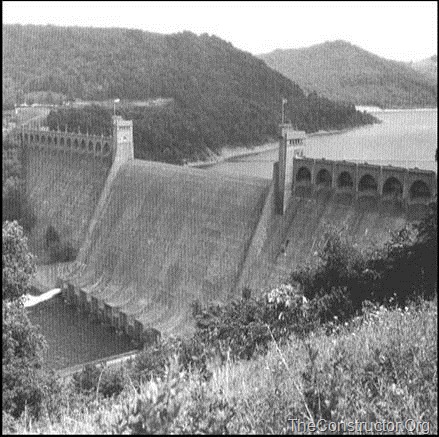
These dams are heavy and massive wall-like structures of concrete in which the whole weight acts vertically downwards
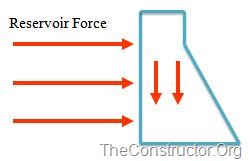
As the entire load is transmitted on the small area of foundation, such dams are constructed where rocks are competent and stable.
- Bhakra Dam is the highest Concrete Gravity dam in Asia and the second highest in the world.
- Bhakra Dam is across river Sutlej in Himachal Pradesh
- The construction of this project was started in the year 1948 and was completed in 1963 .
- It is 740 ft. high above the deepest foundation as straight concrete dam being more than three times the height of Qutab Minar.
- Length at top 518.16m (1700 feet); width at base 190.5m (625 feet), and at the top is 9.14m (30 feet)
- Bhakra Dam is the highest Concrete Gravity dam in Asia and Second Highest in the world.

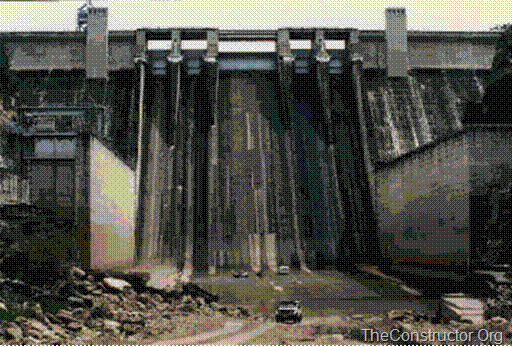
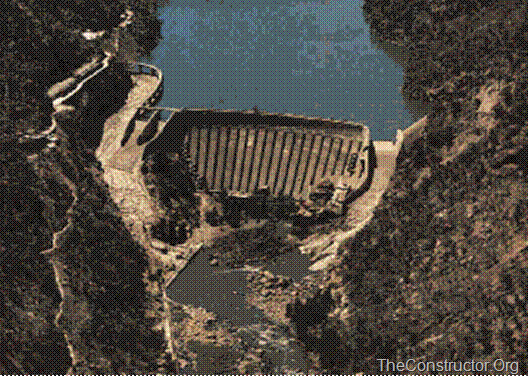
2. ARCH DAM
It is a curved masonry or concrete dam, convex upstream, which resists the forces acting on it by arch action.
The only arch dam in India – Idukki dam (double curvature in plan) – concrete arch dam
Arch Dams
- Arch shape gives strength
- Less material (cheaper)
- Narrow sites
- Need strong abutments
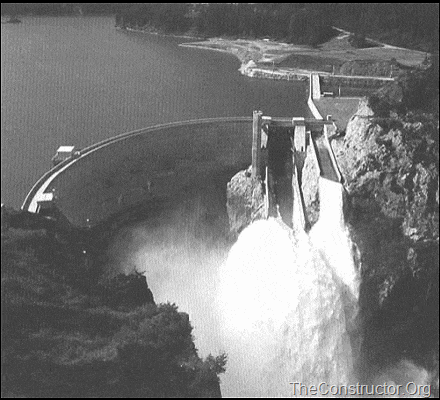
- These type of dams are concrete or masonry dams which are curved or convex upstream in plan
- This shape helps to transmit the major part of the water load to the abutments
- Arch dams are built across narrow, deep river gorges, but now in recent years they have been considered even for little wider valleys.
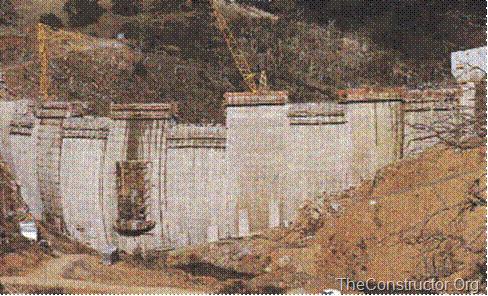
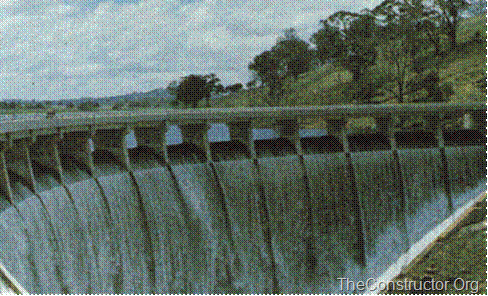
- Good for narrow, rocky locations.
- They are curved and the natural shape of the arch holds back the water in the reservoir.
- Arch dams, like the El Atazar Dam in Spain, are thin and require less material than any other type of dam.
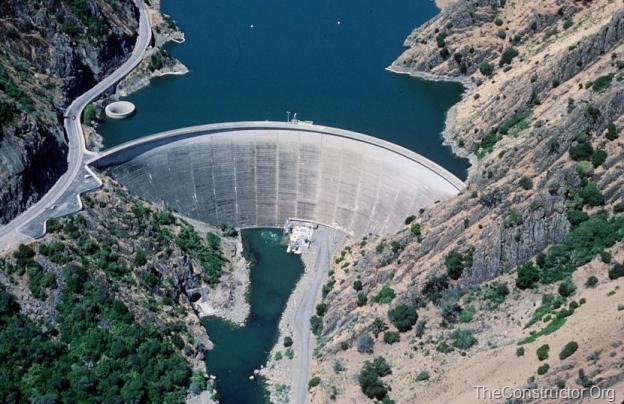
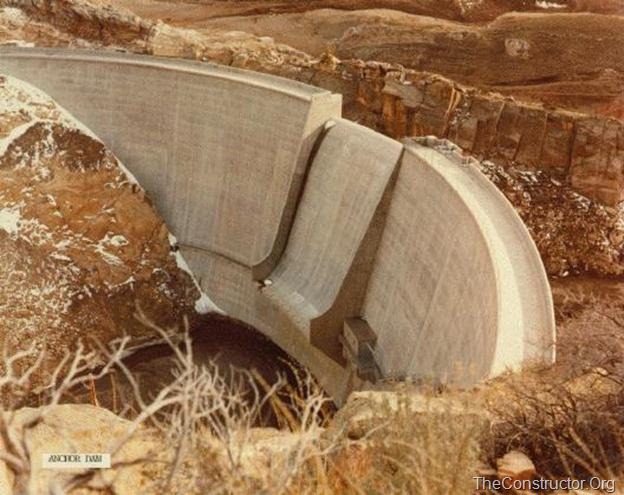
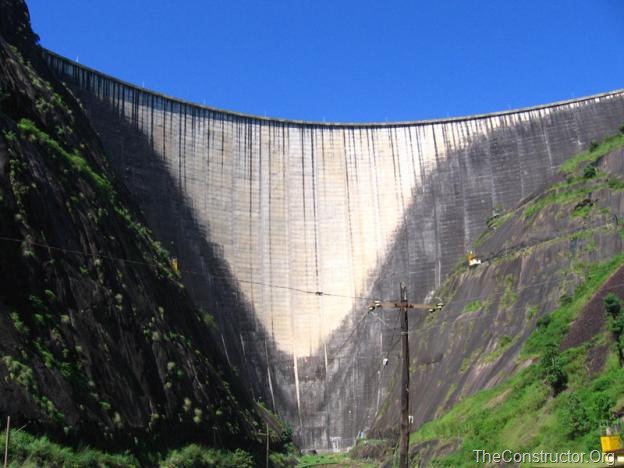
3. BUTTRESS DAM
It consists of water retaining sloping membrane or deck on the u/s which is supported by a series of buttresses. These buttresses are in the form of equally spaced triangular masonry or reinforced concrete walls or counterforts. The sloping membrane is usually a reinforced concrete slab. In some cases, the u/s slab is replaced by multiple arches supported on buttresses (multiple arch buttress dam) or by flaring the u/s edge of the buttresses to span the distance between the buttresses (bulkhead buttress dam or massive head buttress dam). In general, the structural behaviour of a buttress dam is similar to that of a gravity dam.
Buttress Dams
- Face is held up by a series of supports
- Flat or curved face
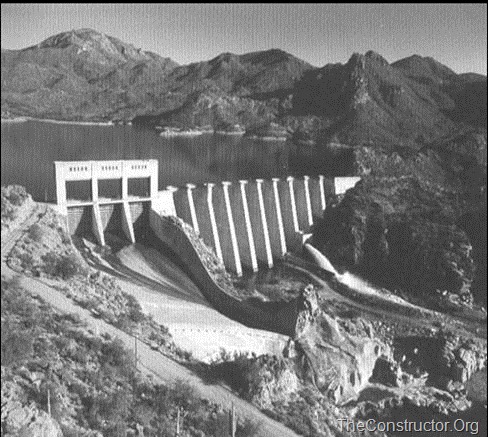
- Buttress Dam – Is a gravity dam reinforced by structural supports
- Buttress – a support that transmits a force from a roof or wall to another supporting structure
- This type of structure can be considered even if the foundation rocks are little weaker.
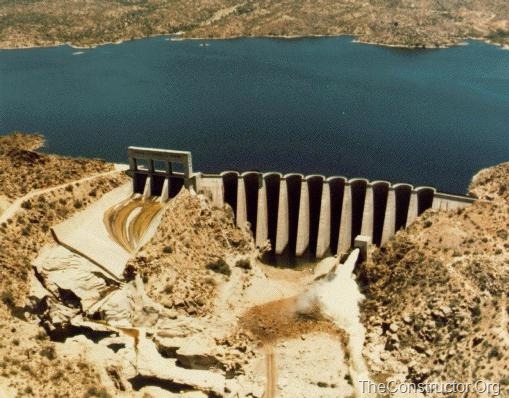
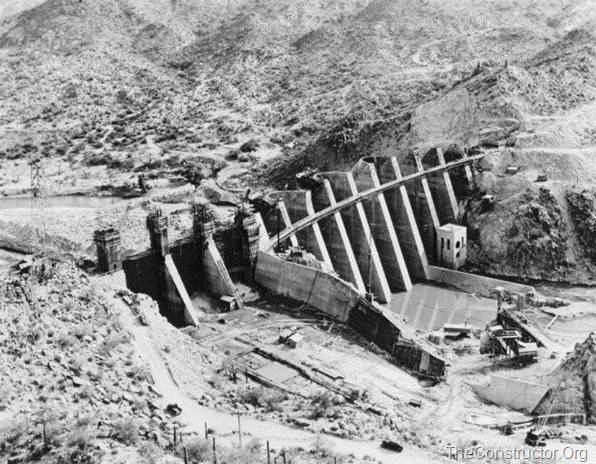
4. EMBANKMENT DAM
It is a non-rigid dam which resists the forces acting on it by its shear strength and to some extent also by its own weight (gravity). Its structural behaviour is in many ways different from that of a gravity dam.
- Earth or rock
- Weight resists flow of water
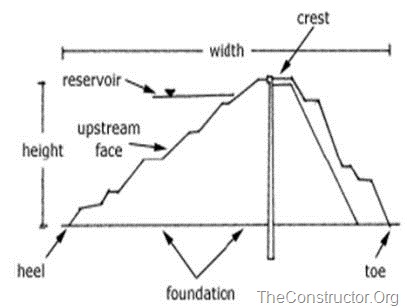
Earth Dams
- They are trapezoidal in shape.
- Earth dams are constructed where the foundation or the underlying material or rocks are weak to support the masonry dam or where the suitable competent rocks are at greater depth.
- Earthen dams are relatively smaller in height and broad at the base.
- They are mainly built with clay, sand and gravel, hence they are also known as Earth fill dam or Rock fill dam.

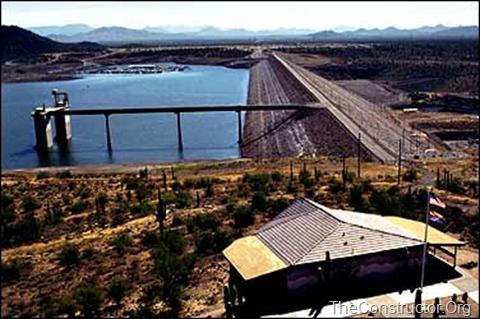
Embankment dams are also armed with a dense, waterproof core that prevents water from seeping through the structure.
Advertisements
Forest Resources – Types of Forests, Uses of Forests - APPSC MAINS PAPER4 SECT-3 Unit -2
The forest is a complex ecosystem consisting mainly of trees that shield the earth and support innumerable life forms. A forest is an area, which has a very high density of trees. Trees are an important component of the environment. They clean the air, cool it on hot days, conserve heat at night, and act as excellent sound absorbers. Forests create a special environment, which, in turn, affects the kinds of animals and plants that can exist.
Different types of forests
India has a diverse range of forests: from the rainforest of Kerala in the south to the alpine pastures of Ladakh in the north, from the deserts of Rajasthan in the west to the evergreen forests in the north-east. Climate, soil type, topography, and elevation are the main factors that determine the type of forest. Forests are classified according to their nature and composition, the type of climate in which they thrive, and its relationship with the surrounding environment.
Forests can be divided into six broad types, with a number of sub types.
| Wet evergreen | Broad leaved | ||
| Semi-evergreen | Pine | ||
| Moist deciduous | Dry evergreen | ||
| Littoral and swamp | |||
| Dry deciduous | Wet | ||
| Thorn | Moist | ||
| Dry evergreen | Dry | ||
| Moist | |||
| Dry | |||
Wet evergreen
Wet evergreen forests are found in the south along the Western Ghats and the Nicobar and Andaman Islands and all along the north-eastern region. It is characterized by tall, straight evergreen trees that have a buttressed trunk or root on three sides like a tripod that helps to keep a tree upright during a storm. These trees often rise to a great height before they open out like a cauliflower. The more common trees that are found here are the jackfruit, betel nut palm, jamun, mango, and hollock. The trees in this forest form a tier pattern: shrubs cover the layer closer to the ground, followed by the short structured trees and then the tall variety. Beautiful fern of various colours and different varieties of orchids grow on the trunks of the trees.
Semi-evergreen
Semi-evergreen forests are found in the Western Ghats, Andaman and Nicobar Islands, and the Eastern Himalayas. Such forests have a mixture of the wet evergreen trees and the moist deciduous tress. The forest is dense and is filled with a large variety of trees of both types.
Moist deciduous
Moist deciduous forests are found throughout India except in the western and the north-western regions. The trees have broad trunks, are tall and have branching trunks and roots to hold them firmly to the ground. Some of the taller trees shed their leaves in the dry season. There is a layer of shorter trees and evergreen shrubs in the undergrowth. These forests are dominated by sal and teak, along with mango, bamboo, and rosewood.
Littoral and swamp
Littoral and swamp forests are found along the Andaman and Nicobar Islands and the delta area of the Ganga and the Brahmaputra. It consists mainly of whistling pines, mangrove dates, palms, and bulletwood. They have roots that consist of soft tissue so that the plant can breathe in the water.
Dry deciduous forest
Dry deciduous forests are found throughout the northern part of the country except in the North-East. It is also found in Madhya Pradesh, Gujarat, Andhra Pradesh, Karnataka, and Tamil Nadu. The canopy of the trees does not normally exceed 25 metres. The common trees are the sal, a variety of acacia, and bamboo.
Thorn
This type is found in areas with black soil: North, West, Central, and South India. The trees do not grow beyond 10 metres. Spurge, caper, and cactus are typical of this region.
Dry evergreen
Dry evergreens are found along the Andhra Pradesh and Karnataka coast. It has mainly hard-leaved evergreen trees with fragrant flowers, along with a few deciduous trees.
Broad-leaved forests
Broad-leaved forests are found in the Eastern Himalayas and the Western Ghats, along the Silent Valley. There is a marked difference in the form of the vegetation in the two areas. In the Silent Valley, the poonspar, cinnamon, rhododendron, and fragrant grass are predominant. In the Eastern Himalayas, the flora has been badly affected by the shifting cultivation and forest fires. These wet forests consist mainly of evergreen trees with a sprinkling of deciduous here and there. There are oak, alder, chestnut, birch, and cherry trees. There are a large variety of orchids, bamboo and creepers.
Pine
Pine forests are found in the steep dry slopes of the Shivalik Hills, Western and Central Himalayas, Khasi, Naga, and Manipur Hills. The trees predominantly found in these areas are the chir, oak, rhododendron, and pine. In the lower regions sal, sandan, amla, and laburnum are found.
Dry evergreen
Dry evergreen forests normally have a prolonged hot and dry season and a cold winter. It generally has evergreen trees with shining leaves that have a varnished look. Some of the more common ones are the pomegranate, olive, and oleander. These forests are found in the Shivalik Hills and foothills of the Himalayas up to a height of 1000 metres.
Wet
Wet montane temperate forests occur in the North and the South. In the North, it is found in the region to the east of Nepal into Arunachal Pradesh, at a height of 1800–3000 metres, receiving a minimum rainfall of 2000 mm. In the South, it is found in parts of the Niligiri Hills, the higher reaches of Kerala. The forests in the northern region are denser than in the South. This is because over time the original trees have been replaced by fast-growing varieties such as the eucalyptus. Rhododendrons and a variety of ground flora can be found here.
In the North, there are three layers of forests: the higher layer has mainly coniferous, the middle layer has deciduous trees such as the oak and the lowest layer is covered by rhododendron and champa.
Moist
This type spreads from the Western Himalayas to the Eastern Himalayas. The trees found in the western section are broad-leaved oak, brown oak, walnut, rhododendron, etc. In the Eastern Himalayas, the rainfall is much heavier and therefore the vegetation is also more lush and dense. There are a large variety of broad-leaved trees, ferns, and bamboo. Coniferous trees are also found here, some of the varieties being different from the ones found in the South.
Dry
This type is found mainly in Lahul, Kinnaur, Sikkim, and other parts of the Himalayas. There are predominantly coniferous trees that are not too tall, along with broad-leaved trees such as the oak, maple, and ash. At higher elevation, fir, juniper, deodar, and chilgoza can be found.
Sub alpine forests extends from Kashmir to Arunachal Pradesh between 2900 to 3500 metres. In the Western Himalayas, the vegetation consists mainly of juniper, rhododendron, willow, and black currant. In the eastern parts, red fir, black juniper, birch, and larch are the common trees. Due to heavy rainfall and high humidity the timberline in this part is higher than that in the West. Rhododendron of many species covers the hills in these parts.
Moist
Moist alpines are found all along the Himalayas and on the higher hills near the Myanmar border. It has a low scrub, dense evergreen forest, consisting mainly of rhododendron and birch. Mosses and ferns cover the ground in patches. This region receives heavy snowfall.
Dry
Dry alpines are found from about 3000 metres to about 4900 metres. Dwarf plants predominate, mainly the black juniper, the drooping juniper, honeysuckle, and willow
he forests are of immense use to the man directly or indirectly. They produce a large variety of woods which are used as fuel, timber and industrial raw material. They also provide many more things out of which bamboos, canes, herbs, drugs, lac, grasses, leaves, oils, etc. are important. They prevent soil erosion, regulate the flow of rivers and reduce the frequency and intensity of floods, check the spread of deserts, add to soil fertility and ameliorate the extremes of climate.
Forest Products
Major forest products consist of timber, small wood and fuel wood including charcoal. Both hard and soft woods are obtained from forests. Hard woods are used for furniture, wagons, tools, etc. Soft woods are light, strong, fairly durable and easy to work and as such are very useful for constructional timbers. They also provide useful raw materials for making paper pulp.
Minor forest products include all products obtained from the forests other than wood and thus comprise products of vegetable and animal origin. Some of the forest products of minor nature are:
- Grasses, bamboos, and canes
- Tans and dyes
- Oils
- Gums and resins
- Fibers and flosses
- Leaves
- Drugs, spices, and poisons
- Edible products
- Animal products (like lac, honey, wax, horns and hides of dead animals etc.)
Indirect Uses
- Prevention and control of soil erosion: Forests play a significant role in the prevention and control of soil erosion by water and wind. The destruction of forest cover leads to increased runoff of rain water and its diminished seepage and storage in soil. The structure of the soil suffers, runoff increases and loosens the soil, which is carried away to other regions. The fertility of the soil is thus lost, and it becomes barren and unproductive.
- Flood control: Roots of the trees absorb much of the rain water and use it slowly during the dry season. Thus they regulate the flow of water and help in controlling the floods. Trees also check the flow of water. With the increased rate of deforestation, the frequency and the intensity of floods in the area also increases.
- Checks on spread of deserts: Sand particles are blown away by strong winds in the deserts and are carried over long distances, thus resulting in the spread of deserts. The roots of trees and plants bind the sand particles and do not permit their easy transportation by winds. In long run, the forests add humidity to the atmosphere and further help in checking the spread of deserts.
- Increase in soil fertility: The fallen leaves of trees add humus to soil after their decomposition. Thus, forests help in increasing the fertility of soil.
- Effect on temperature: Forests have a far reaching effect on climate. They ameliorate the extremes of climate by reducing the heat in summers and cold in winter. They also influence the amount of rainfall by lowering the temperature of moisture laden winds and increase the relative humidity of the air through the process of transpiration. They reduce the surface velocity of winds and retard the process of evaporation.
Advertisements











